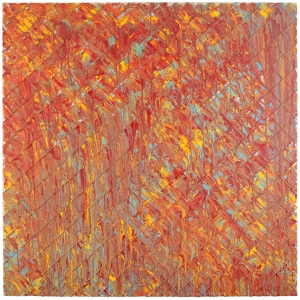Tiemann: Abstract ‘Guru’ of Art
by Susan Honeycutt, arts editor (in The Trinatonian, Trinity University, vol 76 no 3, Sept 22, 1978)
If you are looking for a guru, San Antonio is not the place to go.
And you’re not much better off if it’s modern art you want to become enlightened about.
Maybe this sounds familiar: “That’s neat looking.” “Yeah, but what does it mean?” “I don’t know.” “It doesn’t mean anything.” “Yeah, it’s only paint on canvas.”
One place you might go is to Robert Tiemann. His balding head and grizzled face are more reminiscent of Socrates than any skinny brown Indian guru but he can probably tell you all you want to know.
Tiemann, who has been a member of the art department for 12 years, deserves the distinction of philosopher at least as much as of artist. And like most philosophers, he is utterly alone in his surroundings, at least in terms of the art community in San Antonio.
The reason is that Tiemann is an abstract painter; the context in which he views art sets him apart from many of his local peers.
If you have ever been to an exhibit of modern painting, you have probably concluded that the context is past the understanding of most casual observers. Tiemann would agree, but he believes that a little time spent in study can go a long way toward increasing understanding.
“It’s like there is only one subject in art, but a lot of different levels, a lot of ways of dealing with it.” Where realistic art differs from abstract art is that it “implies a stable point of view… You have man at a fixed point of view, looking at nature, which is also fixed, and therefore measurable with devices like perspective… we know the world isn’t that way anymore.”
Tiemann explained that the questions artists are dealing with today are different from those of the past.
“I think before we asked ‘What does it mean?’ Now we are asking ‘What does it do?’ It’s a demonstration of things rather than a concern for meaning. Art does things… It demonstrates how we perceive ourselves in the universe.”
If that sounds pretty philosophical, you’re right. Tiemann can start out comparing modern art to something as mundane as being in the right ballpark, and before you know it, he is tossing out names like Wittgenstein and Mary Lou Ponti.
Wittgenstein, for instance, is important because “almost all his writing deals with the idea that man is not private, that there is no private inner place that only he has access to. There is no such thing as a private language.”
Tiemann says the same as true of modern art. “Painters who deal with the idea of a private language are as far off base as those who deal with a fixed point view of things.”
He explains good art is art in which what you see is exactly what you’re meant to see.
“I’m interested in doing paintings where all of the decisions are out front,” Tiemann said, “paintings where there are no illusions.”
Visual perception is only a small part of understanding. “Art is to be thought about… Artists don’t make things to look at as much as they make things to think about. It’s asking questions instead of making statements.”

